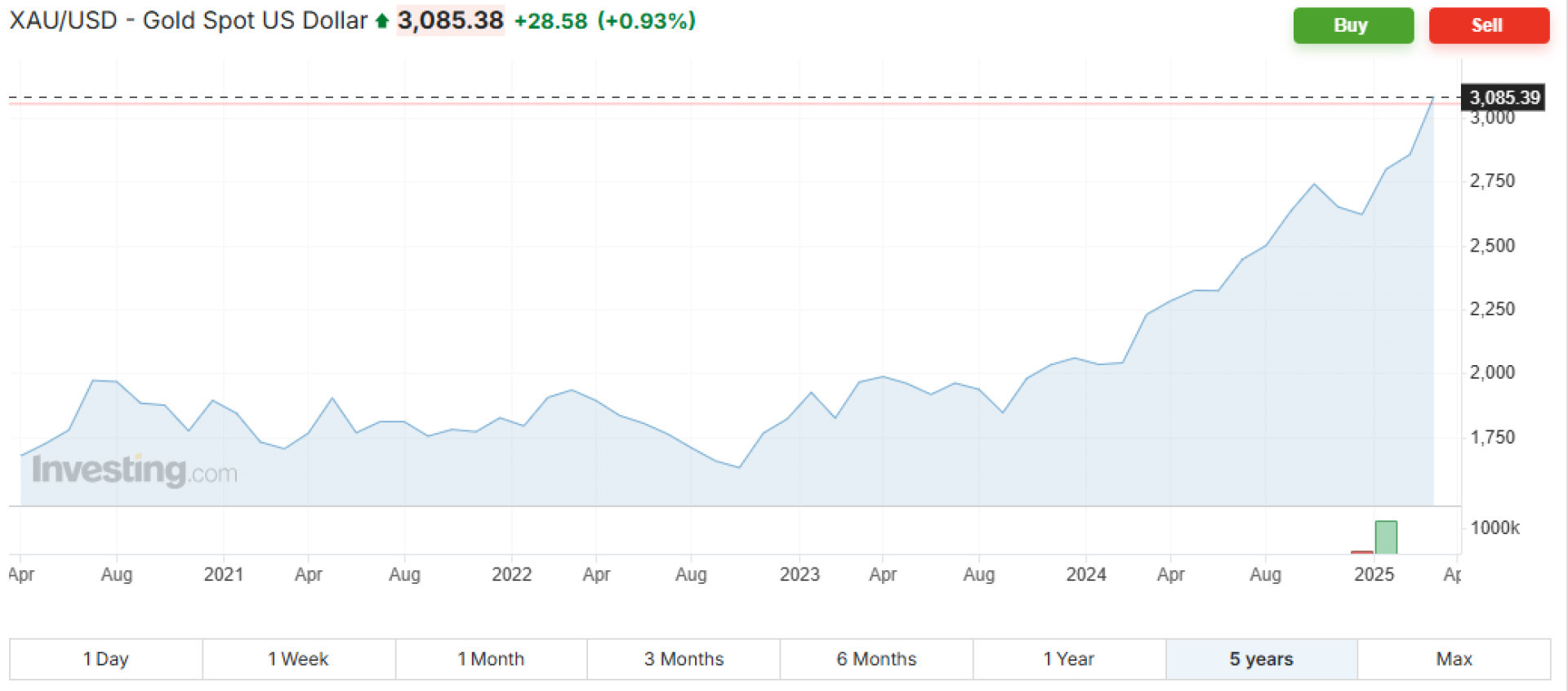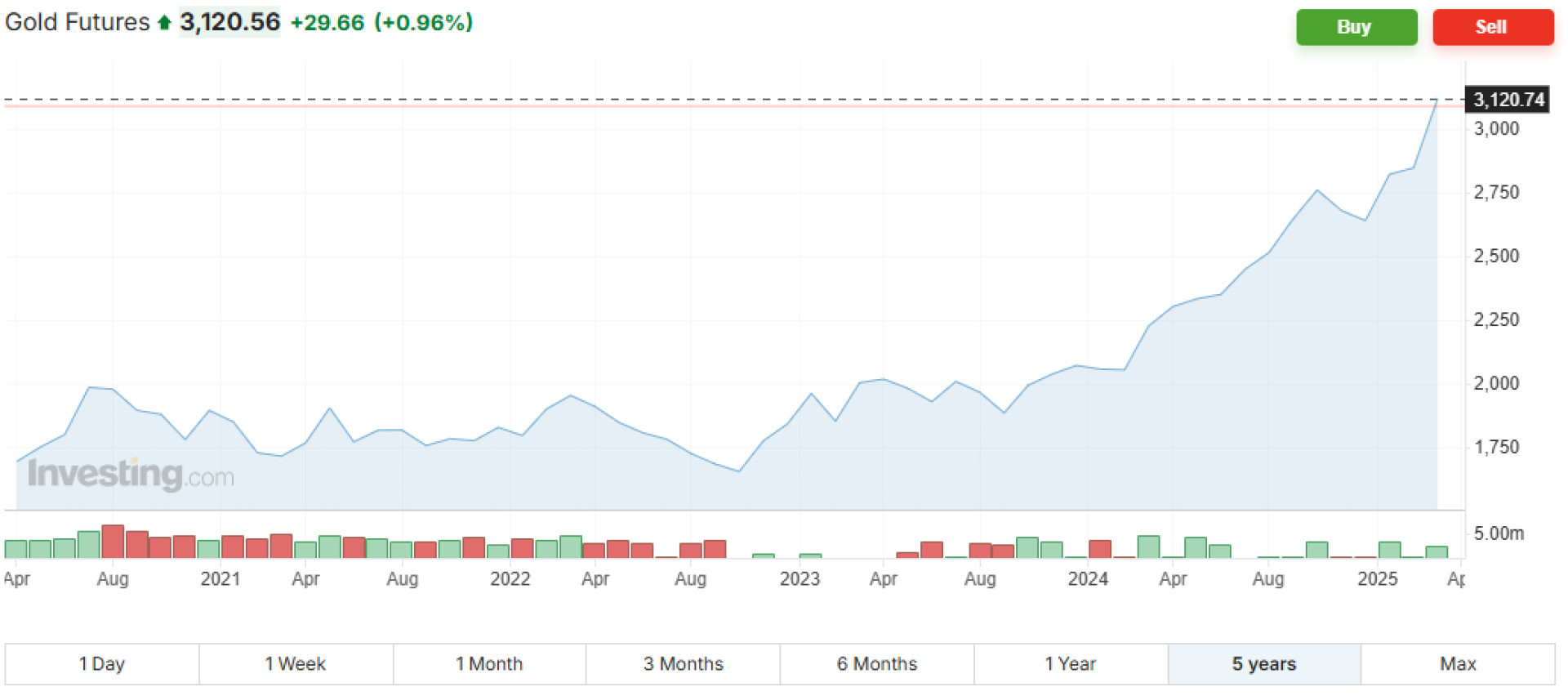Surge to Record Levels
On March 26, 2025, the price of futures contracts on the Comex commodities exchange in New York soared to a historic high of $5.30 per pound (0.45 kg) following new reports related to tariffs. However, by March 28, 2025, it had retreated to $5.16. For comparison, futures contracts were trading 28 percent lower last year, and over a five-year period, the difference is nearly 140 percent.*
Copper Futures Price Development on the Comex Exchange Over the Last Five Years (Source: Trading Economics)*
The opposite scenario unfolded on March 26 at the LME exchange in London, where the price of copper futures for June 2025 delivery fell from the $10,000 mark to $9,927 per ton. The decline was driven by a shift in trading to the U.S. as traders sought to secure copper supplies and hedge against potentially higher prices later in the year. Typically, these exchanges mirror each other's price movements, but this time they did not — highlighting the significant impact tariffs can have on regular trading. By March 28, 2025, the decline deepened to $9,846. Despite the red numbers, the contract price remained 11 percent higher than last year and had surged by more than 100 percent over the past five years.*
Copper Futures Price Development for June 2025 Delivery on the LME Over the Last Five Years (Source: Trading Economics)*
Will Tariffs Be Implemented Sooner?
Copper traders were alarmed by reports that the 25 percent tariffs threatened by the U.S. president could take effect much sooner than initially planned. According to Mining.com, officials investigating copper imports might deliver their findings well ahead of the 270-day deadline. This deadline was set by Trump at the end of February 2025 when he tasked the agency with assessing the volume of foreign copper imports and their potential impact on U.S. national security. What makes the situation even more controversial is that during Donald Trump’s first presidential term, a similar investigation took as long as ten months. While the White House has not officially commented on these reports, they align with previous statements from his trade advisor, Peter Navarro, who suggested that Commerce Secretary Howard Lutnick would ensure the findings reach the president as quickly as possible. According to Goldman Sachs, the tariffs could be implemented as early as November. Although the official reasoning behind the copper tariffs is to boost U.S. production, domestic producers could suffer from higher prices compared to the rest of the world, as the rollout of planned mining projects will take years to complete.
Boosted by China and the Dollar
Copper’s rally in the second half of March was also fueled by economic stimulus measures from China, one of the world's largest importers and producers of the red metal. These measures aim to stimulate consumption and mitigate the impact of tariffs on the country, with a goal of increasing this year’s economic growth to 5 percent while expanding the deficit to 4 percent. The commodity also benefited from a weakening U.S. dollar, as the deepening global trade war and a warning from the Federal Reserve about expected inflationary pressures added to market uncertainty. [1]
Gold Breaks Record After Record
Gold is also benefiting from the trade war, rising inflation, geopolitical tensions, and overall global uncertainty. On March 28, it reached a record high of $3,085 per troy ounce, while June gold futures traded at an all-time high of $3,123. Since the beginning of the year, the precious metal has surged approximately 17 percent, marking its strongest gain in nearly 40 years. Over the past year, gold prices have risen by 38 percent, and compared to five years ago, the increase exceeds 80 percent.*
Spot Gold Price Development Over the Last Five Years (Source: Trading Economics)*
Gold Futures Price Development for June 2025 Delivery Over the Last Five Years (Source: Trading Economics)*
* Past performance is not a guarantee of future results.
[1] Forward-looking statements are based on assumptions and current expectations, which may be inaccurate or influenced by changing economic conditions. These statements do not guarantee future performance and involve risks and uncertainties that are difficult to predict. Actual results may differ significantly from those expressed or implied in any forward-looking statements.



